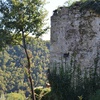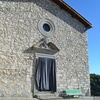Castle of Treppignana
Treppignana stands on a rocky outcrop that is separated from the south-western slopes of the Monte della Tesa. The particularly high position allowed the castle to be able to guard most of the Serchio Valley.
The town plan shows the presence of a small fortress placed on the highest position of the town, corresponding to the current bell tower. This fortress was probably equipped with a square-based tower, eccentrically placed next to the walls. Short stretches of the walls are identifiable even though they are almost completely buried internally, while the exteriors are covered with vines and brambles, which make them difficult to recognise.
Historical notes
A first testimony regarding Treppignana dates back to 983, when it is counted as one of the "villae" which had to pay the census to the parish church of Santa Maria di Loppia. Other mentions are made by the Appraisal by the Diocese of Lucca (1260) and by the records of tithes of 1387, in which the local Church of San Martino is named, placed under the authority of the Parish of Loppia.
It is very probably that this centre, like others in the area between the eleventh and thirteenth centuries, was a fief of the Rolandinghi until their entire domain was acquired by the city of Lucca. The handover is supported by the presence of a delegation from Treppignana at the procession of the Holy Cross in 1308, the event which sanctioned the submission of the populations of the Garfagnana to the government of Lucca. On this occasion a candle weighing a pound, the minimum allowed, was taken as a form of devotional tax, reflecting the fact that the community was very poor.










